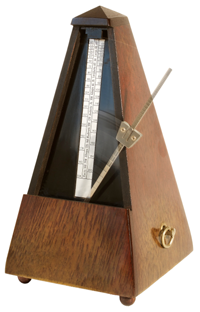
In a previous blog, we discussed how many organizations use a certain type of measurement and verification (M&V) for measuring the effectiveness of their energy management initiatives. But this blog is not about the “how”. This blog is more about the “why”.
Many of us encountered the metronome in childhood experiences with a musical instrument. I spent many hours practicing with it while learning to play the piano. The metronome is a pendulum-like device for marking time like a clock. Except the tick-tock is loud, and you can adjust the speed with a sliding weight mounted on the pendulum. If you’d like to learn more about it, there is a very entertaining metronome entry in Wikipedia.
Value of the Metronome
In music, the metronome is a precise instrument for measuring time and dividing it into little chunks called beats that conductors use to keep the orchestra together. There is a measuring scale on the metronome to adjust the “beats per minute” from about 40 (painfully slow) to 208 (ridiculously fast) and anywhere in-between. And musicians, from beginners to professionals, use it to improve their performance.
The real advantage of the metronome is that it allows everybody in the musical process to come to consensus on how the music is to be played. The composer can add a metronome marking to the musical score. The conductor can check the marking when he/she is preparing the music with an ensemble.
The individual musicians can use their metronomes to practice on their own, and interpret the musical passages in a way that captures the composer’s intent. The metronome gives musicians an agreed-upon standard for musical performance, at least in terms of the flow of the music in time.
Value of Measurement & Verification
In a similar way, measurement and verification (M&V) provides an agreed-upon standard for measuring effectiveness of an energy efficiency initiative. With any energy project, it’s not enough to simply compare year to year out-of-pocket expenditures. You can’t run to the accounting department and ask, “What does the general ledger say,” because conditions have changed since the project began. The weather, utility rates, occupancy, and square footage may have all changed.
So you have to determine correctly what you would have spent in the absence of the energy management project. And that’s the concept of the avoided spending—Cost Avoidance. Like the metronome, Cost Avoidance gives you a measurement tool. But instead of measuring time, you’re measuring money—money you would have spent. And then you’re comparing that cost with your actual cost to determine energy savings.
Missing the Music?
The metronome was invented almost 200 years ago, but it’s still in use today because of the value it brings in music. The M&V cost avoidance methodology was pioneered in the 1980s in FASER Energy Accounting software (now EnergyCAP), and like the metronome, it’s actively used today in energy management software to bring people together and achieve consensus on the effectiveness of energy management initiatives.You can make some beautiful music with that kind of consensus.
If you’re not incorporating cost avoidance as a measure for your facility-based energy management projects, you may be missing the music.
For more about M&V, watch our video:
{{cta(‘e0abeb56-77e8-4259-9164-15acb12754bd’)}}
 Best-in-class portfolio-level energy and utility bill data management and reporting.
Best-in-class portfolio-level energy and utility bill data management and reporting.
 Real-time energy and sustainability analytics for high-performance, net-zero buildings.
Real-time energy and sustainability analytics for high-performance, net-zero buildings.
 A holistic view of financial-grade scope 1, 2, and 3 carbon emissions data across your entire business.
A holistic view of financial-grade scope 1, 2, and 3 carbon emissions data across your entire business.
 Energy and sustainability benchmarking compliance software designed for utilities.
Energy and sustainability benchmarking compliance software designed for utilities.



